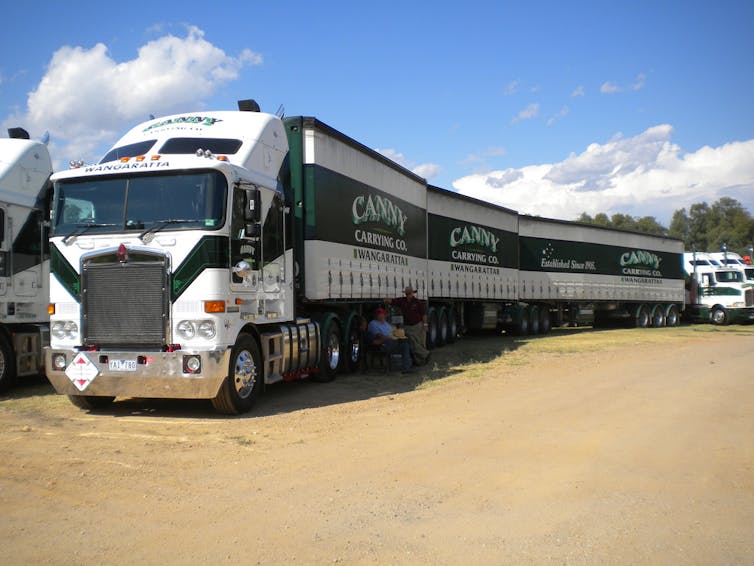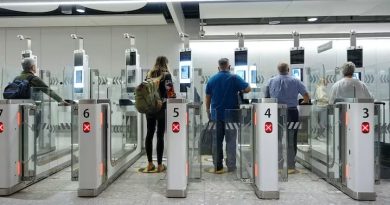Too Many Loads On Our Roads When Rail Is The Answer


The Oasis Reporters
March 30, 2021
Philip Laird, University of Wollongong
“Without trucks, Australia stops” is now a fact of modern life. But when all costs are considered, road freight is an expensive way of moving large amounts of freight. And, as shown by ongoing fatal crashes involving large trucks, road freight can also be dangerous.
The main beneficiaries of road freight are not the truck drivers who work hard in a dangerous occupation, but the companies that choose to consign large quantities of freight by road. Road freight has seen strong growth, in part, due to good service levels and major road improvements that include highways with dual carriageways and concrete pavements, climbing lanes, and town bypasses. Over the past 25 years, road upgrades have allowed for the introduction of larger trucks such as B-doubles.
At the same time underinvestment in rail tracks that support rail freight, along with different standards of cost recovery for heavy truck access to roads (arguably low) and freight trains to rail tracks (often full user pays), has skewed the market.
In addition, the road freight industry is under-regulated while the rail freight industry is over-regulated. These factors together mean more loads are placed on roads with more pressure on truck drivers.
As well, recent investigations have found that certain truck operators have been prepared to cut maintenance and/or tamper with speed limiters.
Road safety
During the 12 months to the end of June 2013, 134 people died in fatal crashes involving articulated trucks (semitrailers, B-doubles and road trains). While this is fewer than five years ago, in terms of distance driven, articulated trucks continue to be over-represented in road fatalities: during 2012-13 articulated trucks were involved in 12% of all Australia’s 1274 road fatalities when articulated trucks account for 3.2% of all vehicle kilometres driven.
New South Wales has seen more than its fair share of fatal accidents involving articulated trucks on public roads. For example, over many years, about one out of three of all fatalities from road crashes on the Hume Highway involved articulated trucks. Of the fatal accidents involving articulated trucks, while many are the result of an action of a car driver, others are not and include either single vehicle accidents (truck only) or the collision of two or more articulated trucks.
The fatal crash that occurred on the Princes Highway south of Ulladulla involving a Cootes tanker became the subject of a coronial inquiry in 2011 that made a number of recommendations. On 1 October 2013, an oil tanker owned by the same company (based in Victoria) was involved in a further fatal crash on the Mona Vale Road in Sydney’s northern beaches. As stated by the NSW NRMA, this double fatality could have been prevented if governments had acted on the coroner’s advice.
Subsequent inspections of the Cootes tanker fleet by NSW authorities has led to ongoing findings of numerous trucks with defects (141 out of 320 trucks checked), leading to NSW Roads Minister Duncan Gay to say: “Cootes Transport has been a repeat offender and enough is enough.”

NSW is considering B-triples on the Hume Highway.
Luke Robinson1/Flickr, CC BY
Weighing up the costs
My research, most recently updated in 2012, found the total average external costs for the movement of one tonne of freight one kilometre in a non urban area by an articulated truck is 2.79 cents, and by rail freight is 0.24 cents (with respective road and rail external costs in urban areas being 3.88 and 0.61 cents per tonne km).
The difference is mainly due to unrecovered road system costs (one cent per net tonne km) and the average accident risk cost for freight moved by articulated trucks being 0.85 cents as against 0.04 cents per tonne km for rail. The ratio is about 20 to 1, suggesting that rail is twenty times safer than articulated trucks as a way of moving freight.
In 2011, independent road safety researcher Peter Mackenzie examined how many lives could be saved if a 15% shift of freight from road to rail (the so-called “contestable freight”) was to take place. For articulated trucks in 2011-12, the number based on the 134 fatalities noted above is 20.
Based on relative fuel use calculations and the size of the Australian articulated road freight task (151 billion tonne kilometres in 2011-12 as noted by the Australian Bureau of Statistics using about 4.3 billion litres of diesel), and rail using one third of the diesel that trucks use in moving non-bulk line haul freight, this would save about 450 million litres of diesel each year. It would also reduce, each year, carbon dioxide emissions by more than one million tonnes and total external costs by more than A$600 million.
Where to from here?
It would make good sense to get some of the longer distance movement of fuel, and other freight, back onto rail. Examples of the loss of rail to road freight over the past 25 years (since the introduction of B-doubles) include rail share of land freight on each of the Melbourne – Sydney and Sydney – Brisbane corridors falling from over 20% in 1989 to less than 5% now. The result is more than 3000 trucks each day and night now on the Hume Highway, and more than 2000 on the Pacific Highway.
In the past five years, more containers and grain have been moved to ports by road instead of rail, quarry products from the South Coast to Sydney have shifted from a coastal ship to road, and Shell has transferred bulk deliveries of fuel from Sydney to Canberra, Dubbo and Tamworth from rail to road.
As noted in 2007 by the chairman of a House of Representatives committee examining freight, Paul Neville MP:
It is now even more obvious that bold measures will be necessary to see a more serious movement of freight from road to rail.
Neville also observed that the freight task is expected to double in the next 20 years, but if nothing is done to improve rail’s competitiveness “our roads will become totally and utterly congested”.
This in part is reflected in the 2013 Queensland Moving Freight Strategy, which lists in its first set of priorities to “expand the use of rail freight”. Despite this, the Australian government has committed A$6.7 billion to further Bruce Highway upgrades and not one dollar for the Queensland North Coast railway.
The 2013 Victorian Freight and Logistics Plan includes a “Mode Shift Incentive Scheme”. However, the 2013 NSW Freight and Port Strategy looks to accommodate more freight by further improving truck productivity with the option of running B-triples on the Hume Highway.
Clearly a more balanced approach is required than has been forthcoming to date.![]()
Philip Laird, Honorary Principal Fellow, University of Wollongong
This article is republished from The Conversation under a Creative Commons license. Read the original article.













